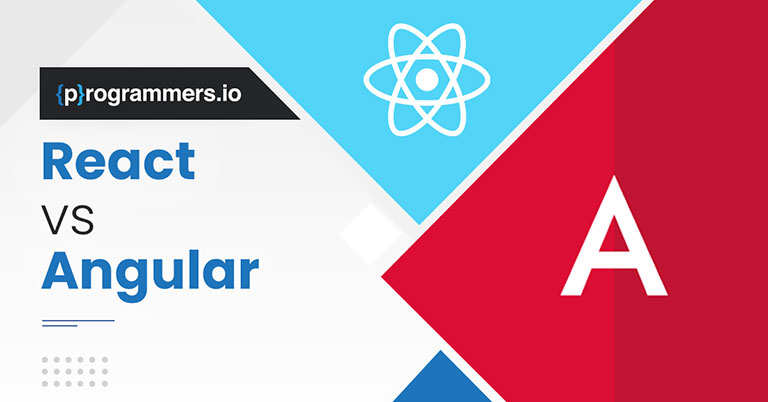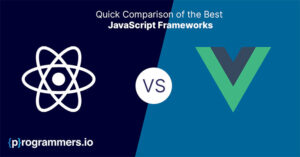It can be challenging for many front-end developers to choose the right JavaScript framework for their project. Some industry experts and online resources will pitch one JavaScript framework as the best option available today while others will advocate for its competitors.
However, there is no reason for you to get confused. We say this because there are some popular JavaScript frameworks today that developers trust more than others and you can simply choose from them. Two frameworks are React and Angular.
Some people believe React and Angular to be the best JavaScript frameworks available today. However, that is up for debate since there are other efficient JavaScript front-end frameworks like Svelte, Vue, and Preact that perform as well as (if not better than) the two JavaScript frameworks we are comparing here.
However, that is a debate for another time. This article looks to compare the React vs Angular frameworks so you can choose the correct option for your development project. So, without further ado, let’s get into the React Vs Angular comparison.
What Is React?
If you want a front-end JavaScript library where you can access reusable user-interface components to build the UI of your applications, React should be your first choice. It offers great flexibility and performance by using server-side rendering and allows you to create complex user interfaces and seamless UX.
React JS development services can take this to the next level by using the JavaScript library to create the ultimate UI and UX experience. Many developers today prefer React for building scalable applications quickly because of the framework’s “Learn Once, Write Anywhere” principle.
You can use this framework with JavaScript and JSX and benefit from its Virtual DOM. Individual developers and Facebook communities maintain this front-end JavaScript framework.
What Are The Advantages of React?
You get many benefits when you hire ReactJS developers. The main advantages of using a React JS development company for your project include the following:
- You can easily debug in React, and the code is reusable.
- A React Native library is present to improve performance.
- The easy and simple design of the framework makes it easy to learn and use.
- Both front-end and server-side support come with faster updates.
- View-oriented ReactJS.
- Android and IOS support.
- React makes it easy to migrate an app.
What Is Angular?
The next most important thing in the React Vs Angular comparison is to understand the latter. If you want to build scale web apps using a framework for application design driven by a component-based architecture containing TypeScript, then Angular is what you need to go for.
You will find many features and libraries that are well-integrated in the Angular framework. Some of the features help to increase front-end development, including routing and client-server communication. You can also benefit from tools that make it easy to develop and scale projects.
Every need can be met with this JavaScript front-end framework whether you’re building a small-scale application or an application for an enterprise. The same engineering team at Google that developed Angular JS has created Angular by completely rewriting the code. However, a large community of developers supports and constantly updates the framework.
What Are The Advantages of Angular?
Like React, Angular has many benefits for developers and those who hire them. Here are the main advantages of Angular that set it apart from other JavaScript front-end frameworks, including React:
- You get an independent and portable structure with React thanks to its Plain Old JavaScript Objects (POJO) Model.
- You can inject dependency into your project and develop clean code using Angular.
- The framework allows data synchronization between the component and model view.
- You can inject the controller with mock data to test a unit in Angular. The next step involves inspecting the outcome and its behavior. You can also create separate pages using Angular and then consolidate them with the components to see the final product.
- HTML syntax is available with Angular. You can create reusable components using directives in the framework.
- You can create solid template solutions by using the libraries in Angular.
- You can create data-binding containing interactive user-interfaces (UIs) with Angular and also benefit from its single routing option.
Now that we understand the React and Angular frameworks and their advantages, let’s do a quick comparison of Angular vs React before we do a more detailed review of the differences.
A Quick Comparison of React Vs Angular
Businesses of all sizes today use Angular and React to build applications. Recent data shows that over 50 million websites are using React today. Angular is also popular, with over half a million websites using it. The numbers suggest that React is more reliable since it has a much higher number of users than Angular. However, you need to consider a lot more before deciding whether to go with Angular developers or a ReactJS development company. Here is a quick comparison of Angular vs React based on several different variables to help you make an informed choice.
| Variable | Variable | Angular |
| Language | JavaScript | TypeScript |
| Developer | Meta (formerly Facebook) | |
| Type | A library based on JavaScript | Full-fledged JavaScript structural framework |
| App Structure | Component-based framework that is fixed and complex. | Component-based and flexible |
| Purpose | Build components for user-interface that are interactive. | Create interactive web apps that are also dynamic. |
| Best For | Single page websites and web applications. Progressive apps. Complex apps being built for enterprises. | Hybrid apps for iOS and Android that are rendered natively. Variable data containing large and modern web apps. |
| DOM | Virtual | Real |
| Learning Curve | Not that big | Tricky for beginners |
| Approach For Front-End Development | Prefers rendering from the server-side. Uses JSX, syntax similar to XML. | Prefers rendering from the client-side. Extends HTML functionality. |
| Dependency Injection | A global state is attached to each component and React is unable to activate dependency injection fully as a result. | Angular makes it possible to create individual lifecycles for different stores by supporting dependency injection. |
| Performance | High | Somewhat high as updates are rendered quickly by Virtual DOM and the runtime performance is faster. |
| Data Binding | React has one-way binding | Angular has two-way binding |
| UI Binding | It links directly to the user-interface states. | It binds user-interface at property or plain object level. |
React Vs Angular: A Detailed Comparison
Now that we have done a quick comparison of these two top JavaScript frameworks, we can proceed to discuss the differences between them in a bit more detail. Here is a detailed comparison of Angular vs. React that looks at different variables.
Performance
The first variable we are going to compare the React vs Angular JavaScript front-end frameworks for is performance. You can build high-performing web apps using the distinct features of both these frameworks but you need to find out which one is faster.
You can optimize your coding practices using Angular to reach a high level of programming that improves performance continually. Angular allows you to easily optimize your proposed code’s digest cycle, for example. It is easy to verify the changes you assessed previously by monitoring the loop and then optimizing it. And you can do all this while you create the codebase for additional modules.
You can also significantly minimize complexities by serving projects that do not require two-way data binding with Angular’s older versions. Additionally, you can improve memorization by using the $cacheFactory and use it later to recalculate the data that will be processed later. Angular also makes web apps faster by using real DOM and a combination of zones and change detection to render pages.
React, on the other hand, improves the performance of an application by using a Virtual DOM. It ensures that developers don’t have to rewrite the HTML document completely to make changes to the front-end. It allows them to render updates faster and more quickly refresh data on web pages to speed up performance.
React also has a competitive edge over Angular in component reusability. If you have multiple projects running you need developers to work on, they can get stuck if they have to deal with complex logic and code they cannot reuse. The reusable components of React help to avoid this situation.
The ability to reuse components also helps designers in improving coding practices and increasing productivity. It does this by providing them with components of every step of the process including the button and the checkbox for the initial stage, the root components for the final steps, and the wrapper components for the steps in between.
All of this helps to keep the performance of the app consistent while ensuring and maintaining code quality, irrespective if how complex the project is.
Language
The JavaScript superset TypeScript is the language Angular uses to help developers using the framework to easily navigate code and find typos. On the other hand, React uses the syntax extension JSX script that makes the code in JavaScript mimic HTML in combination with the JavaScript ES6+.
You can compile JSX code with Babel or another browser using a code translation tool to enhance the React framework. While you can use TypeScript to develop applications in React, keep in mind that the framework does not natively support it.
Data Binding
The next variable we need to compare the React and Angular frameworks for is data binding. Two-way binding is the approach Angular uses here. Any time an element changes in an interface, there is also a change in the model states—and this happens automatically.
Whether you want to build a React SPA or enterprise-level application, the React framework will use one-way data binding to render the interface model changes, but only after you update the model state. And whenever you change the components of the user interface, there will be no change to the model state. There is a unidirectional flow of data in one-way data binding to allow developers using the framework greater control over the mobile and web apps they are working on.
Component Architecture
Angular have the same architecture type: component-based. It means that the elements in both these front-end frameworks are cohesive, modular, and reusable. The only difference is in the technology stack. JavaScript is the go-to solution for the React architecture while TypeScript is used by Angular to create web apps that are concise and error-free.
Components
Controllers, Views, and Models are the three components you will find in Angular. However, the framework has a complex and fixed app architecture that makes it easier for developers to reuse codebases and templates in other projects by separating codes into individual files.
On the other hand, you can write codes in React without using any fixed format. The codebase in React is easily readable and well-structured. You can also logically organize the code by using component trees. The React library uses functional programming to make declarative declarations of components.
Directives
The component’s end explains templates and logic in React. Readers can quickly decipher the code even if the syntax is not known to them. Angular, on the other hand, has templates with unique specifications for setting the object. It is enabled by the attribute assigned to each template. Also, directives in Angular have a complex syntax and it can be confusing for any reader who does not know too much about the technology.
UI Components
Pop-ups, buttons, layouts, and other components for material design are supported by Angular. It helps to ensure a seamless and quick configuration of the user interface. However, you need to install the Dependencies and Material-UI library before you can use the material design components in React. These user-interface components are developed by the community and include both free and paid options.
Popularity
Popularity should not be a measure of how good a JavaScript front-end framework is, but it is still a good indication of its reliability. Starting with React, it is amongst the most searched top JavaScript frameworks on Google. Additionally, Statista ranks it second in the list of web frameworks developers today use the most.
The ready-made solutions of Angular are one of the main reasons many developers prefer it but it is still evolving. The same is the case with React and the reason both are equally popular amongst developers and businesses looking for JavaScript front-end development frameworks.
Tools
There is a difference between the features you get with React and those available in Angular. Also, the latter has a greater dependency on a state management library. The management of the state, routing, and interaction with API, in this case, can be optimized using React Router, Redux, and Helmet.
Angular, on the other hand, has a package with several functionalities include component-based routing, project building, and data binding. Moreover, you do not any external libraries to add components in Angular. However, you use the frameworks for state management like RxJS and NgRx to increase the features in Angular.
DOM
What users see on a browser at a specific time is represented by the Document Object Model (DOM) graph. You can make changes to the user’s view by editing the DOM but keep in mind that it will impact performance. It is the reason both React and Angular look to improve the view re-rendering by the DOM after an update to lower operational costs.
The DOM is important for both frameworks but the type used by each differs. React uses a virtual DOM whereas Angular uses the real type. When you make a change in Angular, you update the entire tree structure. Angular overcomes this problem by looking for components needing changes by using change detection.
React, on the other hand, uses a virtual DOM to change parts of a single element without updating the entire tree structure.
Which Is Better: React or Angular?
Now that we have done a detailed comparison of React and Angular front-end frameworks based on different variables, you would want to know which one is better. The answer to this is not straightforward as both offer several advantages.
You can build great web and mobile apps using component-based architectures with both React and Angular. The best way to choose between these two frameworks is by considering your project workflows and required functionalities and then seeing which frameworks is best aligned with them.
If you’re looking for a front-end framework that allows you to reuse user-interface components and build applications quickly, then you need to go for React. React is also a good choice for developers looking for a framework with a small learning curve for building applications.
Angular, on the other hand, is a great option for developers who want to handle multiple aspects and work on multiple projects at the same time. It is also a good option if you’re fine using a JavaScript front-end framework with a bigger learning curve to build enterprise-level applications.
By considering these things and all the differences between Angular and React, as detailed above, you can choose the right front-end framework for your project.
Frequently Asked Questions (FAQs)
Here are some FAQs related to React and Angular.
What Are The Main Differences Between React and Angular?
There are several differences between React and Angular. However, some differences are more important than others. The first is that Angular is a framework for the front-end while React is a library in JavaScript. Another major difference is that Angular uses binding of the two-way kind while React utilizes one-way binding. Also, Angular has a real DOM, while React has a virtual one.
Which Is Better Between React and Angular?
Both these frameworks have their advantages but if we had to choose one, it would be React. It is because the Virtual DOM and optimized rendering of React helps it to perform better and faster than Angular. Additionally, developers can use many pre-built solutions in React to build applications.
What Are The Things That Make React Better Than Angular?
There are several areas where React does better than Angular, including backward computability, bundle size, and performance. Also, developers can reuse components in React to save time and cost thanks to the framework’s component-driven architecture.
How Are JavaScript and TypeScript Different?
If you want to create web applications, then the JavaScript programming language is the perfect choice. On the other hand, if you’re looking for an object-oriented programming (OOP) language that runs on JavaScript to do the same, you should go for TypeScript.
Which Is Simpler to Use: React or Angular?
If you want a front-end framework that makes it simple to build applications, then go for React, as it comes with many pre-built solutions that make the job of developers easier. On the other hand, if you’re looking for a faster framework that is easier to learn, Angular should be your choice.




